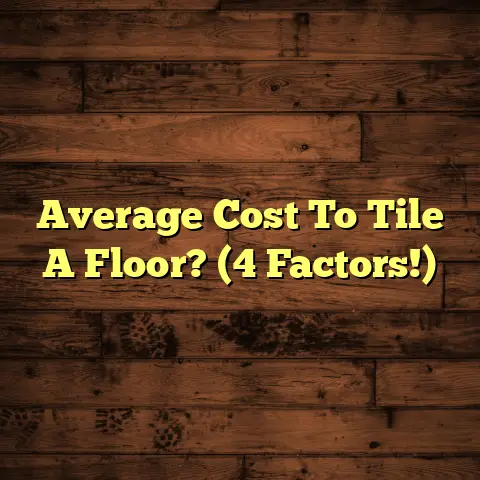Laminate vs. Hardwood: Pros & Cons? (Top 5 Showdown!)
There’s a common misconception I want to address right away: the idea that hardwood is always the superior choice.
Many people think hardwood is the ultimate flooring material, end of story.
But that’s simply not true! Both laminate and hardwood have unique strengths and weaknesses.
The best choice for you depends on your individual needs, budget, and lifestyle.
So, let’s dive into a head-to-head comparison to help you make the right decision.
Section 1: Overview of Laminate Flooring
1. Definition and Composition
What exactly is laminate flooring?
It’s a multi-layered synthetic flooring product designed to mimic the look of real wood (or stone, tile, you name it!).
Think of it like a high-tech photo glued onto a durable surface.
Here’s the breakdown of those layers:
-
Wear Layer: The top layer is a clear, protective coating that resists scratches, stains, and fading.
-
Design Layer: This is a high-resolution photographic image that gives the laminate its realistic appearance.
-
Core Layer: Usually made of high-density fiberboard (HDF) or medium-density fiberboard (MDF), this layer provides stability and impact resistance.
-
Backing Layer: The bottom layer provides a moisture barrier and helps to balance the floor.
The materials used in laminate construction are primarily wood byproducts (like HDF or MDF), resins, and a photographic layer.
2. Types of Laminate Flooring
You might be surprised to learn that there’s more than one type of laminate!
The main difference lies in the manufacturing process and the thickness of the wear layer.
Here are a couple of the most common types:
High-Pressure Laminate (HPL): This type is made by fusing all the layers together under high pressure.
It’s incredibly durable and often used in commercial settings.Direct-Pressure Laminate (DPL): This is the most common type of laminate flooring for residential use.
It’s made by fusing the layers together under lower pressure, making it more affordable than HPL.
3. Durability and Maintenance
Laminate flooring is known for its impressive durability.
That wear layer I mentioned earlier? It’s a superhero against everyday wear and tear.
It’s more resistant to scratches, dents, and fading than many types of hardwood.
Plus, cleaning laminate is a breeze!
A quick sweep or vacuum followed by a damp mop is usually all it takes to keep it looking its best.
I’ve seen laminate floors hold up beautifully in busy households with kids and pets.
Section 2: Overview of Hardwood Flooring
1. Definition and Composition
Now let’s talk about the real deal: hardwood flooring.
Hardwood flooring is made from a single piece of solid wood, or in the case of engineered hardwood, multiple layers of wood.
The key difference is that solid hardwood is one solid piece of wood, while engineered hardwood has a veneer of real wood on top of a plywood or fiberboard core.
Think of engineered hardwood like a fancy sandwich.
2. Aesthetic Appeal
One of the biggest draws of hardwood flooring is its natural beauty.
Each plank has unique grain patterns, colors, and textures that add character and warmth to any room.
You can choose from a wide variety of wood species, each with its own distinct look.
From the light, airy tones of maple to the rich, dark hues of walnut, there’s a hardwood to suit every style.
And let’s not forget about the finishes!
You can opt for a glossy, modern look or a more rustic, matte finish.
3. Durability and Maintenance
Hardwood flooring is durable, but it requires more care than laminate.
Solid hardwood can last for generations if properly maintained.
Engineered hardwood is less prone to warping in humid environments than solid hardwood.
However, hardwood is susceptible to scratches, dents, and moisture damage.
Spills should be cleaned up immediately, and you’ll need to be careful about wearing shoes that can scratch the surface.
Regular maintenance includes sweeping, vacuuming, and occasional refinishing.
Refinishing involves sanding down the old finish and applying a new one, which can restore the floor to its original glory.
Section 3: Pros and Cons of Laminate Flooring
1. Pros of Laminate Flooring
Affordability: Laminate is significantly more affordable than hardwood.
According to HomeAdvisor, the average cost to install laminate flooring is between $6 and $14 per square foot, while hardwood can range from $8 to $25 or more.Variety of Designs: Thanks to that design layer, laminate can mimic the look of virtually any type of wood, stone, or tile.
You’ll find a huge range of styles, colors, and patterns to choose from.Easy Installation: Many laminate floors feature a click-lock system, making them relatively easy to install yourself.
This can save you a lot of money on professional installation costs.Resistance to Moisture: Laminate is more resistant to moisture than hardwood, making it a good choice for kitchens, bathrooms, and basements.
However, it’s still important to clean up spills promptly to prevent damage.
2. Cons of Laminate Flooring
-
Perceived Value: Some people view laminate as a less valuable flooring option than hardwood, which can affect your home’s resale value.
Limited Repair Options: If laminate gets damaged, it can be difficult to repair.
In many cases, you’ll need to replace the entire plank.Sound and Feel: Laminate can sometimes sound hollow or feel less substantial underfoot than hardwood.
However, you can improve the sound and feel by installing a high-quality underlayment.
Section 4: Pros and Cons of Hardwood Flooring
1. Pros of Hardwood Flooring
Longevity: With proper care, hardwood flooring can last for decades, even centuries.
And as I mentioned earlier, it can be refinished multiple times to restore its beauty.Home Value: Hardwood flooring is a desirable feature that can increase your home’s resale value.
Buyers often see it as a sign of quality and craftsmanship.Natural Beauty: There’s just something special about the natural beauty of real wood.
The unique grain patterns, colors, and textures add character and warmth to any room.
2. Cons of Hardwood Flooring
Cost: Hardwood flooring is a significant investment.
The upfront cost of materials and installation can be much higher than laminate.Maintenance: Hardwood requires regular maintenance to keep it looking its best.
This includes sweeping, vacuuming, and occasional refinishing.Susceptibility to Damage: Hardwood is susceptible to scratches, dents, and moisture damage.
You’ll need to be careful about spills, pets, and high-heeled shoes.
Section 5: Top 5 Showdown: Laminate vs. Hardwood
Okay, let’s get down to the nitty-gritty and compare laminate and hardwood in five key areas.
1. Cost Comparison
As you can see, laminate is the clear winner when it comes to cost.
You’ll save money on both materials and installation.
2. Durability and Longevity
Laminate is more resistant to scratches, dents, and fading, making it a good choice for high-traffic areas.
However, hardwood can last for generations with proper care and refinishing.
So, it depends on your priorities.
If you need a floor that can withstand a lot of wear and tear, laminate is a good choice.
If you’re looking for a floor that will last for generations and increase your home’s value, hardwood is a better option.
3. Aesthetic Considerations
This is subjective, but many people prefer the natural beauty of hardwood.
The unique grain patterns, colors, and textures add character and warmth to any room.
However, laminate has come a long way in recent years.
You can find laminate floors that look remarkably like real wood.
Ultimately, it comes down to your personal preferences.
4. Installation Process
Laminate is generally easier to install than hardwood, especially if you choose a click-lock system.
You can often install laminate yourself, saving money on professional installation costs.
Hardwood installation is more complex and typically requires professional expertise.
5. Environmental Impact
Both laminate and hardwood have environmental considerations.
Laminate is made from wood byproducts and resins, while hardwood comes from trees.
Look for laminate floors that are certified by the Forest Stewardship Council (FSC) to ensure that the wood comes from sustainably managed forests.
Consider engineered hardwood with a thin veneer to reduce the amount of harvested wood.
Conclusion: Final Thoughts
So, which is the better choice: laminate or hardwood?
As you can see, there’s no easy answer.
Both options have their unique sets of advantages and disadvantages.
The best choice for you depends on your individual needs, budget, and lifestyle.
-
If you’re looking for an affordable, durable, and easy-to-install flooring option, laminate is a great choice.
-
If you’re looking for a floor that will last for generations, increase your home’s value, and add natural beauty to your space, hardwood is a better option.
I hope this article has helped you understand the pros and cons of laminate and hardwood flooring.
Now you can make an informed decision that’s right for your home.
Happy flooring!





